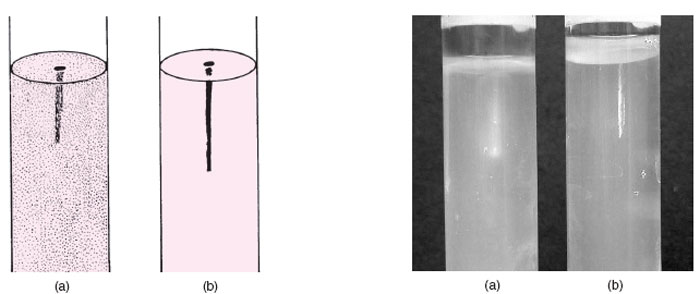Production of Indole and Hydrogen Sulfide, and Motility
Indole is a by-product of the metabolic breakdown of the amino acid tryptophan used by some microorganisms. The presence of indole in a culture grown in a medium containing tryptophan can be readily demonstrated by adding Kovac’s reagent to the culture. If indole is present, it combines with the reagent to produce a brilliant red color. If it is not present, there will be no color except that of the reagent itself. This test is of great value in the battery used to identify enteric bacteria.Hydrogen sulfide is produced when amino acids containing sulfur are metabolized by microorganisms. If the medium contains metallic ions, such as lead, bismuth, or iron (in addition to an appropriate amino acid), the hydrogen sulfide formed during growth combines with the metallic ions to form a metal sulfide that blackens the medium (see colorplate 17 and 19).
The most convenient medium for testing for indole and/or hydrogen sulfide production is SIM medium (SIM is an acronym for sulfide, indole, and motility). This is a tubed semisolid agar that can also be used to demonstrate bacterial motility. It is inoculated by stabbing the wire loop (or preferably a straight wire inoculating needle) straight down the middle of the agar to about one-fourth the depth of the medium and withdrawing the wire along the same path.
| Purpose | To observe how a single medium can be used to test for three distinguishing features of bacterial growth |
| Materials | Tubes of SIM medium Xylene Kovac’s reagent 5-ml pipettes Bulb or other pipette aspiration device Slant cultures of Escherichia coli, Proteus vulgaris, and Klebsiella pneumoniae Broth cultures of Escherichia coli, Proteus vulgaris, and Klebsiella pneumoniae |
Procedures
- Inoculate growth from each of the three slant cultures into separate tubes of SIM medium. Stab the inoculating wire straight down through the agar for a distance of about one-fourth of its depth. Quickly withdraw the wire along the same path (do not move it around in the agar).
- Incubate the tubes at 35°C for 24 hours.
- Examine the tubes for evidence of hydrogen sulfide production (browning or blackening of the medium). Record results.
- Examine the tubes for evidence of motility of the organism. A motile species grows away from the line of stab into the surrounding agar. Lines of growth, or even general turbidity, can be seen throughout the tube. The growth of a nonmotile organism is restricted to the path of the stab (fig. 17.2). Record your observations.
- Set up a hanging-drop or wet-mount preparation of each broth culture to confirm results observed in SIM medium for motility.
- Perform the Kovac test for indole.
- Using a pipette bulb or other aspiration device, pipette 0.5 ml of xylene into the SIM tube (it will layer over the top surface of the agar).
- Pipette 0.5 ml of Kovac’s reagent in the same way as you did the xylene and add it to the SIM tube.
- Observe the color of the xylene layer, and record.
 |
| Figure 17.2 Sketch (left) and photograph (right) of semisolid agar tubes stabbed for motility test. (a) Pattern of growth of a motileorganism. The entire medium is turbid with the growth of the organism, which has moved away from the stab line.(b) Pattern of growth of a nonmotile organism. Only the stab line is turbid with growth. |
Results
Record your observations and results in the table.
 |




